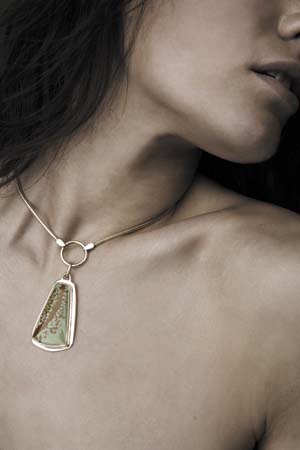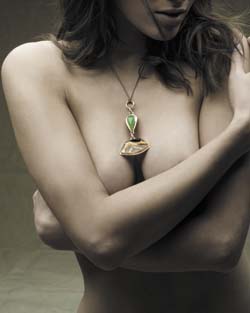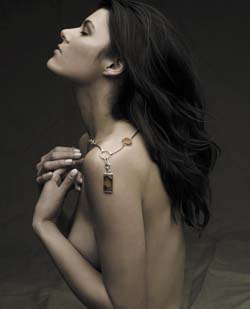|
fashion: 


Be jewelled with the earth-inspired
wonders of Kirsten Muenster’s
new jewellery line. Summer
Rayne Oakes shows that these precious, little pieces have
a big story to tell
photographed by Jon Moe
make-up and hair by Johnny Lavoy
modelled by the author
Expanded
from issue 19 of Lucire
IT’S SOMETHING we girls never seem to outgrow: the pursuit of the
perfect gem. When we were younger, we never hesitated to get our
dress bottoms dirty just so we could peer into the bottom of riverbeds
or beach surf for unfound treasures. When we grew older (save for
the occasional vacation), those clear streams became the clear glass
of storefront windows. The treasures are as precious to us now as
they were back then, but the ones in our glass bowl back
home just seemed to be missing something …
Luckily for us, there is Kirsten
Muenster. The 33-year-old jewellery designer has a great eye
for finding the perfect little gem. Whether in a necklace, bracelet,
or ring, Muenster’s skilful use of metal and stone brings back the
little girl on the surf’s edge. Unlike our random rocks on our bedroom
dressers that seem to be getting a little lacklustre, Muenster is
able to maintain and even enhance the natural integrity of her materials.
This is arguably an art form, a skill that the designer has captured
and perfected since she was a young girl.
Muenster firmly attests: ‘Metal is in my blood.’
It’s an authentic statement coming from the California-based designer.
If you poke around her family roots like a rock hound kicking up
agate stones along a riverbed, you’ll turn up with some interesting,
reaffirming tidbits. Her great-grandfather owned a metal-smith’s
shop in Austria. His son, her grandfather, was a metal sheet worker
and her other grandfather was a coppersmith. Her mother, an antiques
dealer, had also been a strong influence in her life. Young Muenster
began collecting vintage jewellery at a very early age. ‘I have
always been fascinated by the idea that throughout history, people
have felt compelled to adorn their bodies with metal, stones, fibre,
and found objects,’ remarks Muenster.
It is the same bedazzling awe-power that Muenster
harnesses to convey the deeper story beneath each piece. The materials
she uses reflect her politics. Lax policies for worker’s rights
and environmental stability helped put her own work into perspective.
‘I’ve come to acknowledge the fact that the choices I make in my
own work have an impact,’ and undoubtedly Kirsten’s wearable art
pieces are a reflection of that.
Each piece is emblazoned with ethics. She strays
away from using any questionable gem stones such as diamond and
tanzanite, even with the advent of the Kimberly Process, a voluntary
certification scheme that was approved by the international diamond
industry and NGOs in 2002 to help put a stop in the trade of conflict
diamonds. Where she gets her materials are about as varied as her
designs. Most of the stones she uses are found in the United States
and acquired from stone dealers that she has built a trusting relationship
with. She also does her own stone cutting from rocks that had been
found as early as the1940s. Occasionally she’ll recycle stones from
vintage pieces and when she uses fossils, she is sure to get them
from privately owned land. Gold, which she doesn’t use very often,
is always recycled.
Muenster is also exploring untraditional avenues
in pursuit of socially conscious materials. She is currently designing
pieces with the by-products of manufacturing processes. One such
example is her use of reclaimed Fordite. It is not so much a peculiar
stone name until you dig deeper into the story behind the material,
which is also known as Detroit Agate found in the most unlikeliest
of “quarries”: the Ford Motor Company. The exquisitely
beautiful material looks like out-worldly agate stones and are the
end-results of the automotive assembly paint plant process. In addition
to her use of Fordite in her most current collection, Muenster is
also taking to copper fire brick, the by-product of the copper smelting
process. ‘It’s smooth and glimmering. Each piece has the weight
of metal and a patina like antique copper,’ comments Muenster on
the material. ‘Most of the smelters are no longer in operation so
each piece contains a little bit of the history of the upper Midwest.’
It’s part of what is special about her ‘wearable
abstract landscapes.’ Like a modern-day Michelangelo, Muenster carves
her mini-masterpieces with the same keen attention to detail, but
with a preoccupation of something much deeper. ‘I’m drawn in by
the colour, pattern, shape and story behind the materials. But the
choices I make regarding my jewellery,’ explains Muenster, ‘can
be best understood in terms of my attempt to achieve more eco-conscious
selections.’ From the beachfront to the storefront, Kirsten Muenster
jewellery no doubt elicits the same feelings of excitement when
finding the perfect stone, but the true testament of her work is
the socially conscious message buried deep behind the history of
each piece. •
Visit Kirsten Muenster at www.kirstenmuenster.com.
|



Hidden treasures
The materials
she uses reflect her politics. Lax policies for worker’s rights
and environmental stability helped put her own work into perspective.
Each piece is emblazoned with ethics. She strays away from using any questionable gem stones such as diamond and
tanzanite, even with the advent of the Kimberly Process
|

